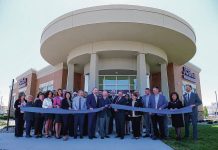The City of Columbus is considering renovation or even demolition to address physical shortcomings in the 70-year-old Donner Center.
The building, which opened in 1947, houses the city’s parks and recreation department and also holds meetings and events. However, the building is showing signs of wear and often requires repairs, said Mark Jones, city parks and recreation director.
The building’s shortcomings were revealed during Mayor Jim Lienhoop’s State of the City address on Thursday at Donner Center.
A comprehensive review, most likely by an outside consultant, will be done of the facility and Donner Park, which has a shelter dating back to 1925, Jones said.
[sc:text-divider text-divider-title=”Story continues below gallery” ]
The city has struggled to maintain the upkeep of the building regarding problems evident throughout the structure, Jones said. Problems include leaking water from ceiling tile and paint peeling on the ceiling of the men’s and women’s locker rooms, he said.
Peeling paint has been a recurring issue, Jones said.
Compliance with the Americans with Disabilities Act is a problem at Donner Center, he said. Accessibility inside the men’s and women’s restrooms poses difficulties for people who use a wheelchair, he said.
“It’s not really designed for that,” Jones said.
Although modern appliances work, much of the original equipment in the kitchen isn’t operational, Jones said. There are also air-flow issues where walls have been created for additional office space, he said.
In addition, a multi-purpose room with two large concrete columns also poses particular challenges for groups wanting to hold events due to the way the room is configured.
There also isn’t enough adequate storage space, Jones said.
Bleachers located outdoors, on top of a roof facing the swimming pool, have weakened the joints, which has caused visible wear inside the multi-purpose room, Jones said. Cracks along the wall are also visible in other parts of the building, he said.
Outside the Donner Center, some bricks are starting to crumble, while there are also Americans with Disabilities Act issues because there are no elevators to help disabled people reach the outdoor bleachers.
Jones said he could not say how soon the study would commence, but stressed action needs be taken soon and hopes the analysis can be done by the end of the year.
“We want to put some time and effort into this and see what it takes,” Jones said.
Input from the public will be used in determining the building’s future, with a desire to do what’s best for the community, Jones said.
“The building was built for the needs in 1947, not 2017,” he said.
All options will be explored, including demolition, he said.
The building received a remodel and addition in 1986, but the city continues to struggle with upkeep of the building, Jones said.
Repairs to the Donner Center’s roof and heating, ventilation and air conditioning were estimated at $450,000 in August 2012. Jones said that two sections of the roof were replaced at that time, while regular maintenance has also been performed on the HVAC system.
“You can put a little money into it, but it’s still a 1947 building,” Jones said. “We’re going to look at Donner Park and Donner Center as a whole.”
Donner Center’s outdoor pool, typically open from Memorial Day through mid-August, is used by the Donner Swim Club and for lifeguard classes, said Jim Lemke, Donner aquatics director. He said the pool, which has the capacity to hold 600 people, remains in good condition.
However, Jones said the pool will also be reviewed as part of the study to determine whether any changes need to be made.
The building is named for philanthropist William Donner, a Columbus native, who provided the land for what is now Donner Park in 1917, according to the city.
[sc:pullout-title pullout-title=”Key points of Lienhoop speech” ][sc:pullout-text-begin]
Relationship building
- Occurring on regional, state and national levels.
- Department heads have been involved in training and planning sessions.
- Columbus hosted 20 southern Indiana mayors in November with presentations on substance abuse; Police Chief Jon Rohde met with 12 other chiefs in Madison last month to discuss drug-related issues.
- Mayor Lienhoop: “Our neighboring communities are dealing with the same issues we are, but often with fewer resources.”
Economic opportunity/educational attainment
- The city approved 16 requests for tax abatements in 2016 that were tied to investments totaling more than $100 million.
- The city increased its funding for economic opportunity and designated a portion of it to be spent on attracting businesses and people to Columbus.
- Greater Columbus Economic Development Corp. and education partners are playing important roles in attract, developing talent. The city committed $750,000 earlier this year for initiatives designed to enhance the quantity and quality of local workforce by improving educational attainment.
- Mayor Lienhoop: “We are investing heavily — with time and money — to generate economic opportunity and to improve the education of our workforce.”
Public safety
- The city is working on a plan to build a fire-safety training facility.
- Violent crime declined last year to about one-fourth of the national average.
- Property crime is about 75 percent higher than the national average.
- Mayor Lienhoop: “Public safety has improved, Columbus is a safe place to live, but there is more work to do.”
[sc:pullout-text-end][sc:pullout-title pullout-title=”Cheer Fund benefit” ][sc:pullout-text-begin]
Columbus firefighters cooked breakfast for about 225 people at Mayor Jim Lienhoop’s State of the City address Thursday morning.
The breakfast was free, and those who attended the event donated $700 to the Columbus Fireman’s Cheer Fund.
The money is used to provide Christmas gifts for underprivileged children in the Columbus area during the holidays.
[sc:pullout-text-end]














